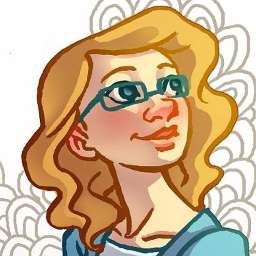Hair can be hard to get right, but it can be a lot of fun! In this tutorial I’m going to cover a few tips that will hopefully make drawing hair a little less difficult and a little more pleasurable.
Pay attention to Origin
Let’s start at the beginning: right at the scalp. The first order of business is the hairline, or the boarder where hair meets bare skin around the forehead and base of the neck. Each hairline is as unique to the individual as any other feature on the face is. Not only do hairlines vary in shape, but also in how high or low they sit on the head. The shape and placement of the hairline determine a lot of how we see the shape of a pearson’s forehead, and it’s worth taking some time to observe the range you can find in real life.

Hair doesn't just sit on top of the head, it grows from it, and you need to keep that in mind when drawing it. Each strand exits the head at an angle more or less perpendicular to the part of the scalp it’s on.

This creates some volume as well as slime interesting twists and turns near the head before the hair is pulled by gravity, styling, or anything else.

Notice how the hair starts at it’s natural angle before it’s pulled another way. The undercut makes this really easy to see Of course hair doesn't just come sticking straight out of the head, although some very curly hair almost seems to, and that’s where you get the afro. But even with an afro, there’s a lot more than that going on, which leads us to our next point.

Shape and Weight
It doesn't work to draw hair as a million little lines. Hair tends to fall in chunks and larger shapes, and it works best to draw it that way: as a three-dimensional shape, or series of shapes.

Hair should also be shaded with this in mind. When light falls across these grouping of strands it tends to describe the shape of that group, and the individual strands appear only as texture.

There are multiple things that affect the shapes that hair makes. Origin is one of them but there’s also gravity, styling, and the hair’s texture itself.

When drawing hair, always keep in mind the direction that the hair is going: where it’s going to and coming from. This will help you make shapes that make sense.

This is especially difficult, but especially important with things like ringlets, where the shape comes from the hair twisting around itself.
The shape of hair can be affected by its own weight. When hair is short or thin, it may have more body/volume on top, because there is less weight pulling it down.

But as hair gets thicker and/or longer, it’s shape may appear more bottom heavy.

Shorter strands will often break from the main body at a curve because they have less length for gravity or styling to pull them in a new direction.

Also, keep in mind that hair is soft. Make sure you are describing it with soft and/or thin lines depending on the medium you are working in.

Tightly curled hair works in shapes too, but it’s influenced by the added volume and texture of the culr., It is fleecy in texture, and less heavily affected by gravity.

When drawing the texture of curly hair, make sure to vary your line. Hair is organic, so don’t just draw a bunch of consecutives semi-circles.

Hair in Action
Hair can also be a good storytelling tool. Aside from style saying a lot in and of itself, hair is very free moving: it is lighter and more flexible than flesh, and so it is easily moved and influenced.

It can also be a good environment cue exhibiting less visible things such as wind, moisture, or lack or gravity.

Again, it’s good to keep in mind the shape of the hair, and the forces affecting it: where the strands are coming from, where they are going, and what is pulling them in that direction, as well as the hair’s inherent texture, volume and weight.
Like all good things, drawing hair takes practice. I’d recommend looking up some photos or observing different hairstyles from life. Take some time to break down the shapes and analyze the direction of the strands and the way they affect texture and volume etc. I hope this tutorial held some useful tips for you and maybe helped you to wrap your brain around how hair works and how to draw it a little better.
Thanks for reading!



